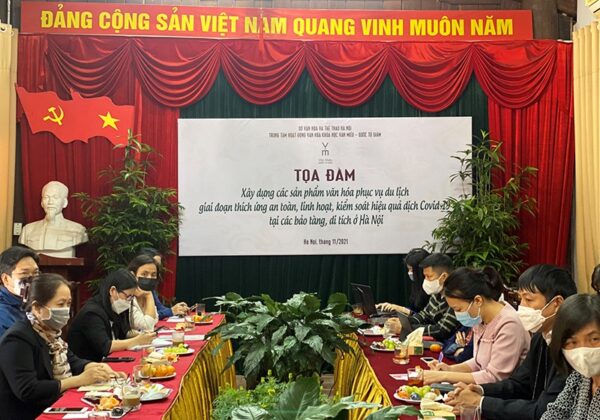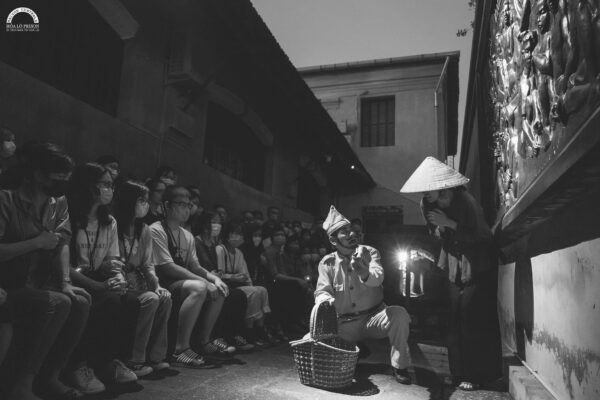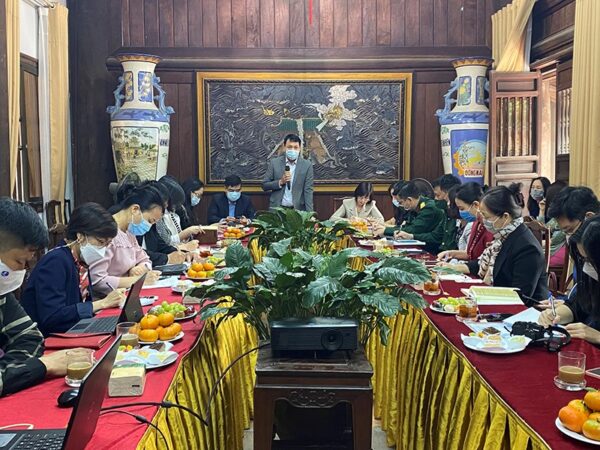
Overview of the Talkshow.
At the talkshow, many comments were raised by managers, cultural experts, representatives of museums, relics, travel organizations, etc., contributing ideas and sharing experiences to overcome difficulties and turn current challenges into opportunities to build products that are suitable for the specific conditions of each unit; sharing experiences to build cultural products of current museums and relics from theory to practice, from mechanisms to policies, socialization, use of technology, human resources, communication… The comments also mentioned the issues of linkage and coordination between museums and relics with business units, travel companies, etc. to mobilize resources to overcome difficulties and create sustainable development for the units in the coming time. In addition, at the talkshow, the relic museums also mentioned the obstacles in the policy mechanism, especially that related to socialization, and at the same time wished to be removed and created a safe and open legal corridor to promote creativity.
Diversification of tourism products
The Covid-19 pandemic affects all industries and fields in society, and heritage promotion activities and cultural tourism services are no exception. To promptly adapt, many museums and relics in the capital area have quickly overcome difficulties, changed the method of public approach as well as have appropriate cultural products to adapt to the new situation, meeting the needs and tastes of visitors and tourists in which the enhancement of technology application, diversification of specific products, enhancement of the experience created … are focused on by museums and relics. For example, Vietnam Women’s Museum, National History Museum, Hoa Lo Prison Relic… quickly built online tours to shorten the distance between destinations and visitors; the Vietnam Museum of Ethnology, instead of waiting for the visitors, actively brought cultural products to schools.
Head of the Management Board of Hoa Lo Prison Relics Nguyen Thi Bich Thuy shared the building of Sacred Night tour is Hoa Lo’s first step to raising Vietnamese people’s love of Vietnamese history. However, in the Covid-19 pandemic, the relic had to close, its revenue decreased, and the relic was forced to cut contracts. Therefore, at present, human resource is one of the difficulties of the unit. The Hoa Lo continues deploying 3 Sacred Nights; at the same time, also considers building a special Sacred Night for both Vietnamese and foreign tourists to experience guides. Along with that, at thematic exhibitions, Hoa Lo Prison relic also organizes exhibition space combined with animation, reconstruction of living spaces of soldiers, prisoners…; each exhibition will create a highlight depending on the content performed. Besides, Ms. Nguyen Thi Bich Thuy also emphasized the importance of association and coordination with travel agencies to create the success of the Sacred Nights.

Sacred Night Tour at Hoa Lo Prison ruins.
Deputy Head of the Exhibition and Public Communication Department of the Vietnam Museum of Ethnology An Thu Tra said: “In the context of the pandemic, the Museum identifies small groups, families potential visitors, the products should be developed for this target group, such as being a farmer catching fish in an artificial stream, organizing activities to learn about traditional culture… or actively bringing activities to schools instead of waiting for students. Due to creative application, in the past two weekends, the Museum of Ethnology welcomed 500 visitors to visit and experience. It is not a high but meaningful number during this time.
According to the Director of the Center for Cultural Activities of the Temple of Literature – Quoc Tu Giam Le Xuan Kieu, along with the restoration of Phuong Dinh at Kim Chau mound, the Center proposed the idea of implementing a pedestrian street at the Temple of Literature and Quoc Tu Giam on weekends, turning this area into a cultural space with an ecosystem of many cultural activities related to the Temple of Literature – Quoc Tu Giam. In particular, the Center is promoting the building of a night tour to exploit the beauty of the Temple of Literature – Quoc Tu Giam at night, applying 3D Mapping technology to tell the story of Vietnamese religion. If this product is completed, it will combine with the night product of Hoa Lo Prison and Thang Long Imperial Citadel to create a unique tourism product of Hanoi.
Building products based on customer needs and tastes
Through the talkshow, it can be seen that applying technology is a solution that many units consider and deploy. They consider this an inevitable trend to attract tourists when the Covid-19 pandemic still has many complicated developments and potential prolongation. But it is also a problem for destinations to consider and choose because technology always changes over time and needs to be updated regularly not to fall behind. According to Vice Chairman of Hanoi Travel Association Le Thanh Thao, technology is the solution to diversify products and increase the attractiveness of the destination, but the main product lines of heritage destinations still need to be field tours to bring direct feelings and experiences. “Destinations need to actively communicate, exchange and promote new products to help travel agencies easily access, thereby building suitable and high-quality tours, raising the level of sightseeing and experiences for visitors”.

At the talkshow, many solutions were proposed to improve the effectiveness of heritage promotion and stimulate cultural tourism.
Vice President of the Vietnam Cultural Heritage Association Le Thi Minh Ly stated that cultural products need to be identified in terms of the targets which should be expanded, but first of all, they must serve well and attract the local communities. Units need to build products based on customer needs and tastes instead of using what is available. Besides, information technology, despite its many advantages, should still be considered only as a means to serve innovation and knowledge. Therefore, it is necessary to focus on training and fostering the workforce so that they can have satisfactory products, not only helping to stimulate tourism demand but also ensuring the goal of promoting and honoring the heritage.
Vice President of the Vietnam Cultural Heritage Association Le Thi Minh Ly stated that cultural products need to be identified in terms of the targets which should be expanded, but first of all, they must serve well and attract the local communities. Units need to build products based on customer needs and tastes instead of using what is available. Besides, information technology, despite its many advantages, should still be considered only as a means to serve innovation and knowledge. Therefore, it is necessary to focus on training and fostering the workforce so that they can have satisfactory products, not only helping to stimulate tourism demand but also ensuring the goal of promoting and honoring the heritage.
The Covid-19 pandemic has had a strong impact on the reception of visitors for museums and relics, but if the risk is turned into opportunities, it is also an opportunity for museums and relics to change their image, creating a premise for sustainable development in the post-Covid-19 period, Deputy Director of the Department of Cultural Heritage, Ministry of Culture, Sports and Tourism Pham Dinh Phong said that museums and relics need to change their thinking in operation; attach importance to building digital database; study the visiting needs of visitors in each period; identify suitable products within museums and relics to attract visitors; focus on professional training for staff. When applying 4.0 technology, museums and relics need to study and learn the experience of units that have had initial success to avoid the case that the technologies become obsolete after they have just applied.
To Nga
